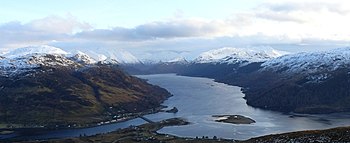
Loch Duich (Scottish Gaelic: "Loch Dubhthaich") is a sea loch situated on the western coast of Scotland, in the Highlands.

Loch Duich (Scottish Gaelic: "Loch Dubhthaich") is a sea loch situated on the western coast of Scotland, in the Highlands.
In 1719, British forces burned many homesteads along the loch's shores in the month preceding the Battle of Glen Shiel.

Eilean Donan Castle stands at the meeting point of Loch Duich, Loch Long, and Loch Alsh.
A legend connected with Loch Duich states that three brothers who went fishing at the loch one night became enraptured by three seal-maidens who had thrown off their furs, assumed the likeness of humans, and danced in the moonlight on the sands. The brothers stole their furs, intending to claim the seal-maidens as their wives. The youngest brother, however, moved by the seal-girl's distress, returned her seal-skin. For his kindness, the girl's father allowed the youngest brother to visit the maiden every ninth night. As for the other two brothers, the middle brother lost his wife after the seal-maiden he had captured found her stolen fur, while the eldest brother burnt his wife's fur as a preventative measure, only to burn her accidentally in the process. [1]
The infamous "McRae film" connected with the Loch Ness Monster was supposedly shot as a close-up of not only "Nessie" in its habitat of Loch Ness, but a second film allegedly shows a similar animal in Loch Duich. Both films are, according to most sources, held in a secret trust, and few people have seen either film. It is still a mystery as to whether the films exist at all, but are accepted by several Loch Ness researchers.[ citation needed ]
Loch Duich, along with the neighbouring sea lochs of Loch Long and Loch Alsh, was together designated as a Nature Conservation Marine Protected Area (NCMPA) in 2014. The designation is in place to protect the lochs' burrowed mud and their flame shell beds. [2]

The Loch Ness Monster, affectionately known as Nessie, is a mythical creature in Scottish folklore that is said to inhabit Loch Ness in the Scottish Highlands. It is often described as large, long-necked, and with one or more humps protruding from the water. Popular interest and belief in the creature has varied since it was brought to worldwide attention in 1933. Evidence of its existence is anecdotal with a number of disputed photographs and sonar readings.
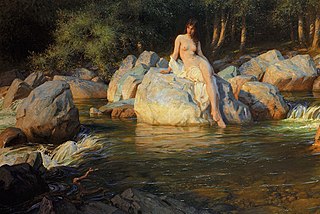
A kelpie, or water kelpie, is a shape-shifting spirit inhabiting lochs in Irish and Scottish folklore. It is usually described as a grey or white horse-like creature, able to adopt human form. Some accounts state that the kelpie retains its hooves when appearing as a human, leading to its association with the Christian idea of Satan as alluded to by Robert Burns in his 1786 poem "Address to the Devil".

The River Ness is a river in Highland, Scotland, UK. It flows from Loch Dochfour, at the northern end of Loch Ness, north-east to the mouth of the Beauly Firth at Inverness, a distance of about 6 miles, with a fall in height of about 16 metres. The river is the origin of the name of Inverness, which is from Scottish Gaelic: Inbhir Nis, meaning "Mouth of the Ness".

The Great Glen, also known as Glen Albyn or Glen More, is a glen in Scotland running for 62 miles (100 km) from Inverness on the edge of the Moray Firth, in an approximately straight line to Fort William at the head of Loch Linnhe. It follows a geological fault known as the Great Glen Fault, and bisects the Scottish Highlands into the Grampian Mountains to the southeast and the Northwest Highlands to the northwest.

Scottish mythology is the collection of myths that have emerged throughout the history of Scotland, sometimes being elaborated upon by successive generations, and at other times being rejected and replaced by other explanatory narratives.
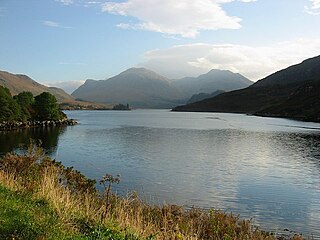
Loch Long is a sea loch situated on the western coast of Scotland, in the Highlands. It is a popular destination for tourists and fishers.
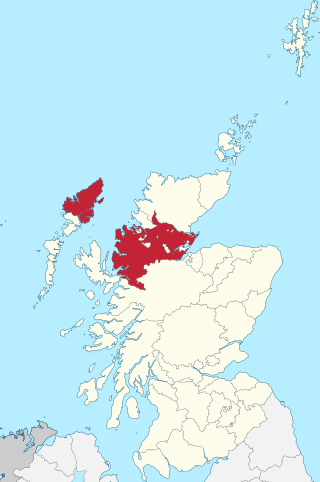
Ross-shire is a historic county in the Scottish Highlands. The county borders Sutherland to the north and Inverness-shire to the south, as well as having a complex border with Cromartyshire – a county consisting of numerous enclaves or exclaves scattered throughout Ross-shire's territory. Ross-shire includes most of Ross along with Lewis in the Outer Hebrides. Dingwall is the traditional county town. The area of Ross-shire is based on that of the historic province of Ross, but with the exclusion of the many enclaves that form Cromartyshire.
The glaistig is a ghost from Scottish mythology, a type of fuath. It is also known as maighdean uaine, and may appear as a woman of beauty or monstrous mien, as a half-woman and half-goat similar to a faun or satyr, or in the shape of a goat. The lower goat half of her hybrid form is usually disguised by a long, flowing green robe or dress, and the woman often appears grey with long yellow hair.
The Northwest Highlands are located in the northern third of Scotland that is separated from the Grampian Mountains by the Great Glen. The region comprises Wester Ross, Assynt, Sutherland and part of Caithness. The Caledonian Canal, which extends from Loch Linnhe in the south-west, via Loch Ness to the Moray Firth in the north-east splits this area from the rest of the country. The city of Inverness and the town of Fort William serve as gateways to the region from the south.
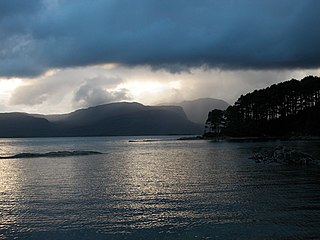
Loch Carron is a sea loch on the west coast of Ross and Cromarty in the Scottish Highlands, which separates the Lochalsh peninsula from the Applecross peninsula, and from the Stromeferry headland east of Loch Kishorn. It is the point at which the River Carron enters the North Atlantic Ocean.

Kintail is a mountainous area sitting at the head of Loch Duich in the Northwest Highlands of Scotland, located in the Highland Council area.

Ciste Dhubh is a mountain in the Scottish Highlands, between Glen Shiel and Glen Affric. With a height of 979 metres (3,212 ft), it is classed as a Munro. It is almost surrounded by glens: Fionngleann (north), An Caorann Mòr (east) and Allt Cam-bàn (west), with the Bealach a' Chòinich pass (south) linking it to the mountain of Sgùrr an Fhuarail. Its name comes from Scottish Gaelic A' Chiste Dhubh, "the black chest", possibly referring to the dark rocky summit.

Loch Alsh is a sea inlet between the isle of Skye in the Inner Hebrides and the Northwest Highlands of Scotland. The name is also used to describe the surrounding country and the feudal holdings around the loch. The area is rich in history, and is increasingly popular with tourists.

Glen Shiel is a glen in the Northwest Highlands of Scotland.

Loch Ness is a large freshwater loch in the Scottish Highlands extending for approximately 37 kilometres southwest of Inverness. It takes its name from the River Ness, which flows from the northern end. Loch Ness is best known for claimed sightings of the cryptozoological Loch Ness Monster, also known affectionately as "Nessie". It is one of a series of interconnected, murky bodies of water in Scotland; its water visibility is exceptionally low due to the high peat content of the surrounding soil. The southern end connects to Loch Oich by the River Oich and a section of the Caledonian Canal. The northern end connects to Loch Dochfour via the River Ness, which then ultimately leads to the North Sea via the Moray Firth.

The Water Horse: Legend of the Deep is a 2007 fantasy drama film directed by Jay Russell and written by Robert Nelson Jacobs, based on Dick King-Smith's children's novel The Water Horse. It stars Alex Etel as a young boy who discovers a mysterious egg and cares for what hatches out of it: a "water horse" which later becomes the fabled Loch Ness Monster. The film also stars Emily Watson, Ben Chaplin and David Morrissey.

Lochalsh is a district of mainland Scotland that is currently part of the Highland council area. The Lochalsh district covers all of the mainland either side of Loch Alsh - and of Loch Duich - between Loch Carron and Loch Hourn, ie. from Stromeferry in the north on Loch Carron down to Corran on Loch Hourn and as (south-)west as Kintail. It was sometimes more narrowly defined as just being the hilly peninsula that lies between Loch Carron and Loch Alsh. The main settlement is Kyle of Lochalsh, located at the entrance to Loch Alsh, opposite the village of Kyleakin on the adjacent island of Skye. A ferry used to connect the two settlements but was replaced by the Skye Bridge in 1995.

Erbusaig Bay is a remote coastal embayment, on a 266° orientation, located on the west coast of the Lochalsh peninsula, in Ross and Cromarty in Scottish Highlands in the west coast of Scotland. At the western side of Erbusaig Bay is the small township of Erbusaig.

In Scotland, Marine Protected Areas (MPAs) are areas of sea defined so as to protect to habitats, wildlife, geology, undersea landforms, historic shipwrecks, and to demonstrate sustainable management of the sea. As of December 2020, approximately 37% of Scotland's seas are covered by the Scottish MPA network, which comprises 244 sites in total.
57°14′N5°28′W / 57.233°N 5.467°W